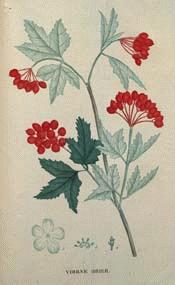
Botanical.com Home Page

|
European Cranberrybush
(Viburnum opulus LINN.)
Click on graphic for larger image
|
Guelder Rose
Botanical: Viburnum opulus (LINN.)
Family: N.O. Caprifoliaceae
---Synonyms---Cramp Bark. Snowball Tree. King's Crown. High Cranberry. Red Elder. Rose Elder. Water Elder. May Rose. Whitsun Rose. Dog Rowan Tree. Silver Bells. Whitsun Bosses. Gaitre Berries. Black Haw.
---Part Used---Bark.
---Habitat---The 'Gaitre-Beries' of which Chaucer makes mention among the plants that 'shal be for your hele' to 'picke hem right as they grow and ete hem in,' are the deep red clusters of berries of the Wild Guelder Rose (Viburnum Opulus, Linn.), a shrub growing 5 to 10 feet high, belonging to the same family as the Elder, found in copses and hedgerows throughout England, though rare in Scotland, and also indigenous to North America, where it is to be found in low grounds in the eastern United States.
---Description---It resembles the Common Elder in habits of growth, hence in some districts we find it called Red Elder or Rose Elder. The conspicuous, large, nearly flattopped heads of snow-white flowers are 3 to 5 inches across, the inner ones very small, but with an outer ring of large, showy, sterile blossoms, containing undeveloped stamens with no pollen and an ovary without ovules. Only the inner, complete flowers provide the nectar for the attraction of insects who are to fertilize them. The resulting fruits, which ripen very quickly, form a drooping cluster of bright red berries, shining and translucent, perhaps the most ornamental of our wild fruits, the tree presenting a very beautiful appearance in August, when they are ripe, especially as the leaves assume a rich purple hue before falling. But although edible, the berries, in spite of Chaucer's recommendation, are too bitter to be palatable eaten fresh off the trees, and when crushed, smell somewhat disagreeable, though birds appreciate them and in Siberia the berries used to be, and probably still are, fermented with flour and a spirit distilled from them. They have been used in Norway and Sweden to flavour a paste of honey and flour.
In Canada, they are employed to a considerable extent as a substitute for Cranberries and are much used for making. a piquant jelly, their sourness gaining for them there the name of High Bush Cranberry, though the tree is, of course, quite unrelated to the true Cranberry.
The name Guelder comes from Gueldersland, a Dutch province, where the tree was first cultivated. It was introduced into England under the name of 'Gueldres Rose.' The garden variety, Viburnum sterile, with snowball flowers, does not produce the showy fruit of the wild species.
The berries have anti-scorbutic properties. They turn black in drying and have been used for making ink.
The wood, like that of the Spindle Tree and Dogwood, is used for making skewers.
[Top]
---Medicinal Action and Uses---The bark, known as Cramp Bark, is employed in herbal medicine. It used formerly to be included in the United States Pharmacopoeia, but is now omitted though it has been introduced into the National Formulary in the form of a Fluid Extract, Compound Tincture and Compound Elixir, for use as a nerve sedative and anti-spasmodic in asthma and hysteria.
In herbal practice in this country, its administration in decoction and infusion, as well as the fluid extract and compound tincture is recommended. It has been employed with benefit in all nervous complaints and debility and used with success in cramps and spasms of all kinds, in convulsions, fits and lockjaw, and also in palpitation, heart disease and rheumatism.
The decoction (1/2 oz. to a pint of water) is given in tablespoon doses.
The bark is collected chiefly in northern Europe and appears in commerce in thin strips, sometimes in quills, 1/20 to 1/12 inch thick, greyish-brown externally, with scattered brownish warts, faintly cracked longitudinally. It has a strong, characteristic odour and its taste is mildly astringent and decidedly bitter.
---Constituents---The active principle of Cramp Bark is the bitter glucoside Viburnine; it also contains tannin, resin and valerianic acid.
---Preparations and Dosages---Fluid extract, 1/2 to 2 drachms. Viburnin, 1 to 3 grains.
Its constituents are identical with the species of Viburnum that is more widely used and is an official drug in the United States, viz. Viburnum Prunifolium or Black Haw, though Cramp Bark contains 1/3 the resin contained in Black Haw and its similar properties are considered much weaker.
Fluid Extract of Cramp Bark has a reddishbrown colour and the slight odour and somewhat astringent taste of the bark.
Common Name Index
A MODERN HERBAL Home Page
Bear in mind "A Modern Herbal" was written with the conventional wisdom of the early 1900's. This should be taken into account as some of the information may now be considered inaccurate, or not in accordance with modern medicine.
© Copyright Protected 1995-2025 Botanical.com
|

